Trees ( IF 2.3 ) Pub Date : 2024-04-18 , DOI: 10.1007/s00468-024-02510-z Vikram Singh , Krishna G. Misra , Ram R. Yadav , Akhilesh K. Yadava

|
The increasing number of climate-associated disasters in the Himalayan region causing a huge impact on human life and the ecosystem are the bellwethers of climate change. Weather records from the high Himalayas, though sparse and limited to the past few decades, show its sensitivity to global climate change. However, short observational records preclude our understanding of long-term climate variation over the topographically controlled Himalaya. In view of this, tree-ring data of Himalayan birch trees from the cold-arid Lahaul-Spiti, Himachal Pradesh, western Himalaya is analyzed in the present study. The response function analysis of Himalayan birch chronologies with climate variables revealed a significant impact of February–March minimum temperature in radial growth of Himalayan birch. Taking this relationship as a guide, we developed the first record of winter/spring (February–March) minimum temperature for this region. The reconstructed minimum temperature record reveals annual to decadal scale variability associated with several prolonged cold and warm periods. A strong association of warm/cold phases of February–March temperature with low/high snow water equivalent of western Himalaya, as well as seasonal snow and glacial derived streamflow of the upper Indus River basin was identified. The observed hydrological linkages were further tested using river flow records of the Satluj and Indus Rivers of the western Himalaya. The observed opposite relationship between winter–spring minimum temperature and the summer hydro-climatic records can be of immense use to policymakers, agriculture stockholders, and hydropower project officials to take precautionary measures in advance.
中文翻译:

印度喜马偕尔邦寒冷干旱的拉胡尔-斯皮提 2 月至 3 月最低气温记录及其水文影响
喜马拉雅地区气候相关灾害日益增多,对人类生活和生态系统造成巨大影响,是气候变化的风向标。喜马拉雅山高处的天气记录虽然稀疏且仅限于过去几十年,但显示出其对全球气候变化的敏感性。然而,短暂的观测记录妨碍了我们对受地形控制的喜马拉雅山长期气候变化的理解。鉴于此,本研究对来自喜马拉雅西部喜马偕尔邦拉胡尔-斯皮提的喜马拉雅白桦树的年轮数据进行了分析。喜马拉雅白桦年表与气候变量的响应函数分析揭示了2-3月最低气温对喜马拉雅白桦径向生长的显着影响。以这种关系为指导,我们开发了该地区冬季/春季(二月至三月)最低气温的第一个记录。重建的最低温度记录揭示了与几个长期寒冷和温暖时期相关的年度到十年尺度的变化。研究发现,二月至三月的暖/冷阶段温度与喜马拉雅山西部的低/高雪水当量以及印度河上游流域的季节性降雪和冰川衍生水流之间存在很强的关联。利用喜马拉雅山西部萨特卢季河和印度河的河流流量记录进一步测试了观察到的水文联系。观察到的冬春季最低气温与夏季水文气候记录之间的相反关系对于政策制定者、农业股东和水电项目官员提前采取预防措施有很大帮助。



























 京公网安备 11010802027423号
京公网安备 11010802027423号